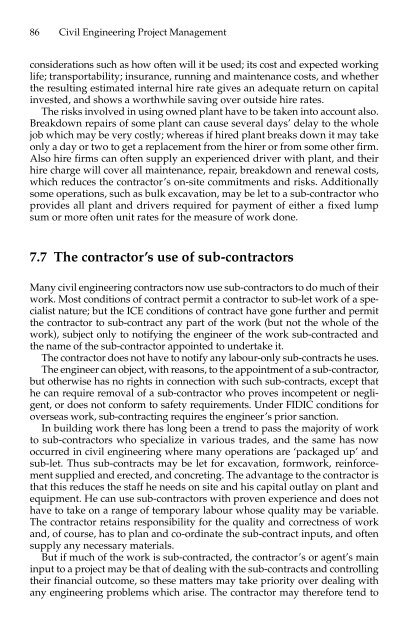Civil Engineering Project Management (4th Edition)
Create successful ePaper yourself
Turn your PDF publications into a flip-book with our unique Google optimized e-Paper software.
86 <strong>Civil</strong> <strong>Engineering</strong> <strong>Project</strong> <strong>Management</strong><br />
considerations such as how often will it be used; its cost and expected working<br />
life; transportability; insurance, running and maintenance costs, and whether<br />
the resulting estimated internal hire rate gives an adequate return on capital<br />
invested, and shows a worthwhile saving over outside hire rates.<br />
The risks involved in using owned plant have to be taken into account also.<br />
Breakdown repairs of some plant can cause several days’ delay to the whole<br />
job which may be very costly; whereas if hired plant breaks down it may take<br />
only a day or two to get a replacement from the hirer or from some other firm.<br />
Also hire firms can often supply an experienced driver with plant, and their<br />
hire charge will cover all maintenance, repair, breakdown and renewal costs,<br />
which reduces the contractor’s on-site commitments and risks. Additionally<br />
some operations, such as bulk excavation, may be let to a sub-contractor who<br />
provides all plant and drivers required for payment of either a fixed lump<br />
sum or more often unit rates for the measure of work done.<br />
7.7 The contractor’s use of sub-contractors<br />
Many civil engineering contractors now use sub-contractors to do much of their<br />
work. Most conditions of contract permit a contractor to sub-let work of a specialist<br />
nature; but the ICE conditions of contract have gone further and permit<br />
the contractor to sub-contract any part of the work (but not the whole of the<br />
work), subject only to notifying the engineer of the work sub-contracted and<br />
the name of the sub-contractor appointed to undertake it.<br />
The contractor does not have to notify any labour-only sub-contracts he uses.<br />
The engineer can object, with reasons, to the appointment of a sub-contractor,<br />
but otherwise has no rights in connection with such sub-contracts, except that<br />
he can require removal of a sub-contractor who proves incompetent or negligent,<br />
or does not conform to safety requirements. Under FIDIC conditions for<br />
overseas work, sub-contracting requires the engineer’s prior sanction.<br />
In building work there has long been a trend to pass the majority of work<br />
to sub-contractors who specialize in various trades, and the same has now<br />
occurred in civil engineering where many operations are ‘packaged up’ and<br />
sub-let. Thus sub-contracts may be let for excavation, formwork, reinforcement<br />
supplied and erected, and concreting. The advantage to the contractor is<br />
that this reduces the staff he needs on site and his capital outlay on plant and<br />
equipment. He can use sub-contractors with proven experience and does not<br />
have to take on a range of temporary labour whose quality may be variable.<br />
The contractor retains responsibility for the quality and correctness of work<br />
and, of course, has to plan and co-ordinate the sub-contract inputs, and often<br />
supply any necessary materials.<br />
But if much of the work is sub-contracted, the contractor’s or agent’s main<br />
input to a project may be that of dealing with the sub-contracts and controlling<br />
their financial outcome, so these matters may take priority over dealing with<br />
any engineering problems which arise. The contractor may therefore tend to


















